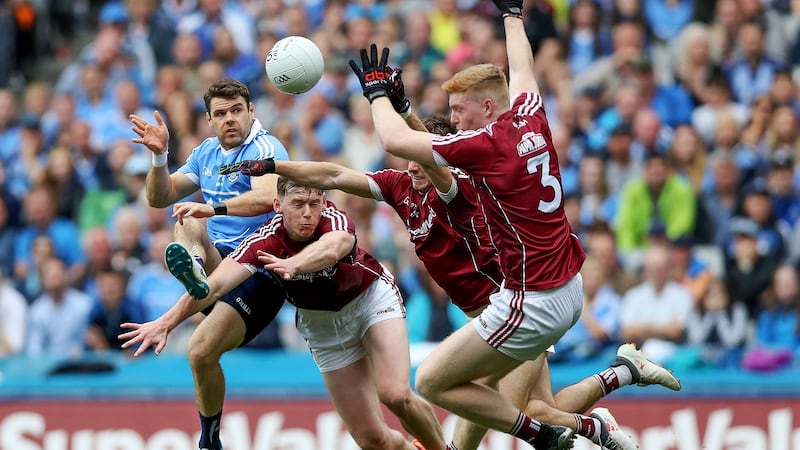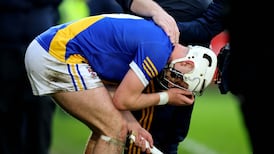Dublin against Clare last Saturday should’ve given rise to plenty of nostalgia pieces about 1992 – the Munster football final win over Kerry, Maughan’s shorts, Vinny Murphy, Kevin Costner in the stands... it was all heady, redolent stuff.
In reality, I saw one piece online about it, but hardly a word besides. Who could get too excited about Dublin/Clare, in a three-quarters empty Croke Park, in Division Two? The TV cameras were elsewhere, and with good reason. Kerry, Armagh and Mayo are the three really exciting teams to watch at the moment, teams who always seem to end up in good games, and they were all on national television as part of your Saturday night in.
And then Clare deliver a performance like they did, and Dublin come as close to losing this game as they did, and you find yourself questioning what you saw from Dublin last summer all over again.
Dublin may still have a large part to play in this championship, but what has become clear is that they’re just another team now. After two All-Ireland semi-final defeats, relegation, and now struggles in Division Two, the aura of the previous decade has dissipated into thin air.
READ MORE
What exactly the aura of a team means can be hard to define – but like Justice Potter Stewart’s verdict on hard-core pornography, while you might not be able to define it, “you know it when you see it”. It wasn’t just that Dublin were so much better than everyone else, it’s that they stole the soul of their championship opponents for the guts of a decade.
[ The football league may be competitive but it has also become a recurrent eliteOpens in new window ]
Galway reached a league final in 2018, performed creditably against Dublin in that decider before losing, and yet still, for all the positive moves that had been made that year, the idea of facing Dublin in the championship brought Galway supporters like myself out in a cold sweat.
When it did happen later that year, in the All-Ireland semi-final, it wasn’t pretty – 1-24 to 2-12 seems like a bad day at the office, but it was actually even worse than that. The sense of inevitability in the stadium that day was spirit-crushing. This was how it was for everyone, with the honourable exception of Mayo, for an uninterrupted stretch of six years.

It wasn’t even the teams that they were playing directly – every Division One team had to try to tailor their entire style of play to come up with something that might work against Dublin. And so even games that didn’t involve Dublin descended into games where neither side had any interest in giving the ball away in transition, because they knew that even if they got away with it today, they’d never get away with it against Dublin. They wouldn’t get the ball back for four or five minutes.
Football seemed stuck, but now more and more teams are embracing a less risk-averse version of the game, and it’s Dublin who are stuck. Their ideology can be pretty easily summed up – they don’t kick the ball out long to Brian Fenton at midfield, and they don’t kick the ball long into Con O’Callaghan at full forward.
[ Jonny Cooper slowly adjusting to life outside Dublin’s inner circleOpens in new window ]
Lumping it long is not so much a tactic from before this Dublin team, as it is something from before the 1990s, but within this rather simplified version is a fair degree of truth. The Dublin players are now so conditioned to hold on to the ball that the idea of rolling the dice and kicking contestable balls for the opportunity to win big match-defining moments appears to be anathema to them.
After the defeat by Donegal in 2014, Dublin spent a long hard winter of introspection, and came out in 2015 with an entirely new way of playing. They played the most thrilling football of the century in 2013 and 2014, but they vowed never to concede 3-14 in a championship game again, as they did to Donegal that day.
The change brought them success on a scale never before seen in the GAA – six All-Ireland championships in a row. Weaning themselves off the methods that brought that level of success is necessarily difficult.
But watching Mayo and Armagh mix up their games so thrillingly this spring, watching Galway and Kerry rolling the dice and being happy to win 60 per cent of their own kick-outs if it moves them into the right area of the field, the thought occurs that Dublin have stood still. And if they don’t experiment in Division Two, there’s hardly any chance we’ll see change come championship.
What remains clear is that they have the players to destroy teams. Jack McCaffrey’s return has been as seamless (and explosive) as Dublin fans prayed it would be – there’s a solid argument they might have four less points in this league without his cameos.
A change of style would play to the strengths of their best players. I don’t really buy the panic over them having had to depend on Fenton, James McCarthy, Con and McCaffrey over the last couple of weeks – that’s what great players do, they win you games you scarcely deserve. Asking them to continue doing it for the rest of the year is the worry. Right now, teams are sniffing blood. And next up is Derry, in the Bogside.
















